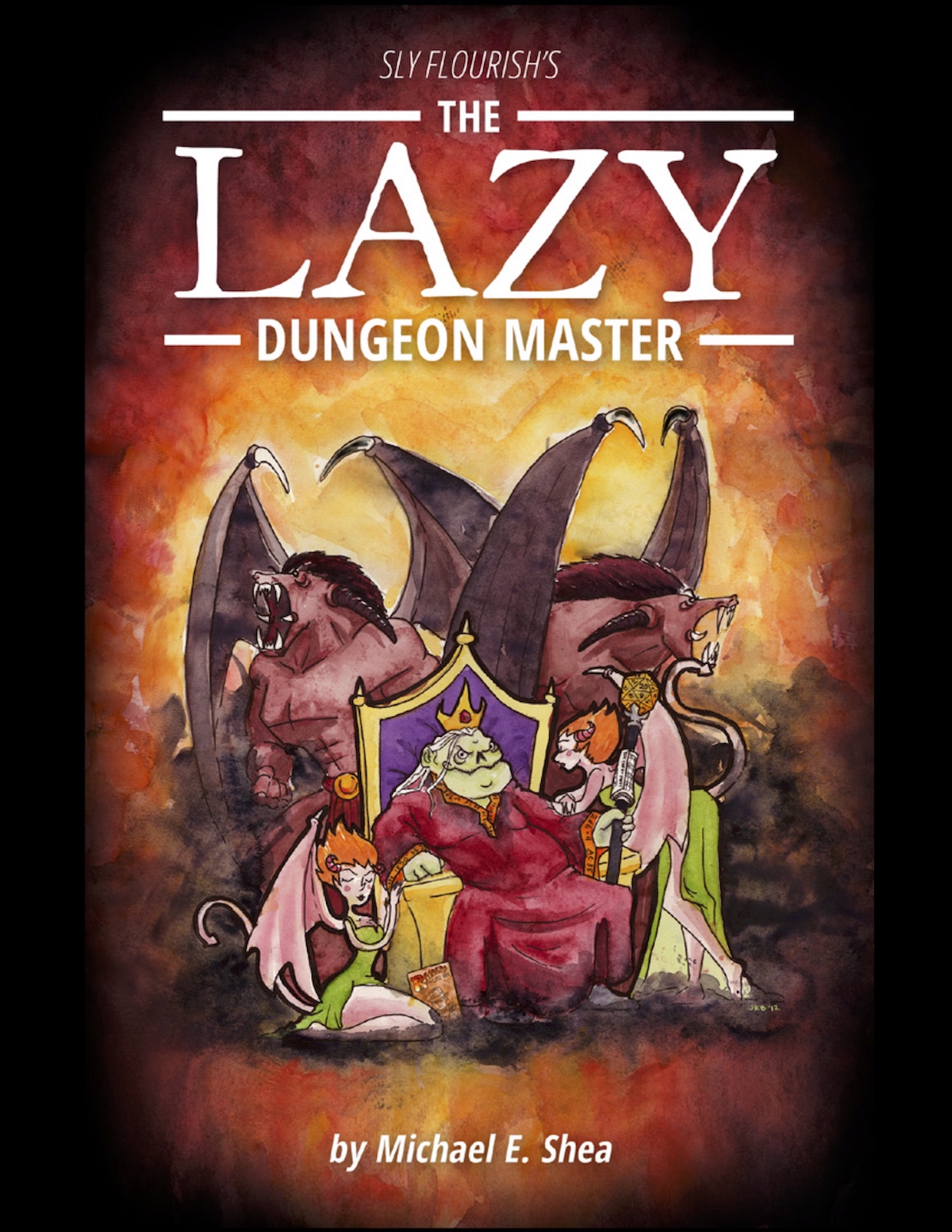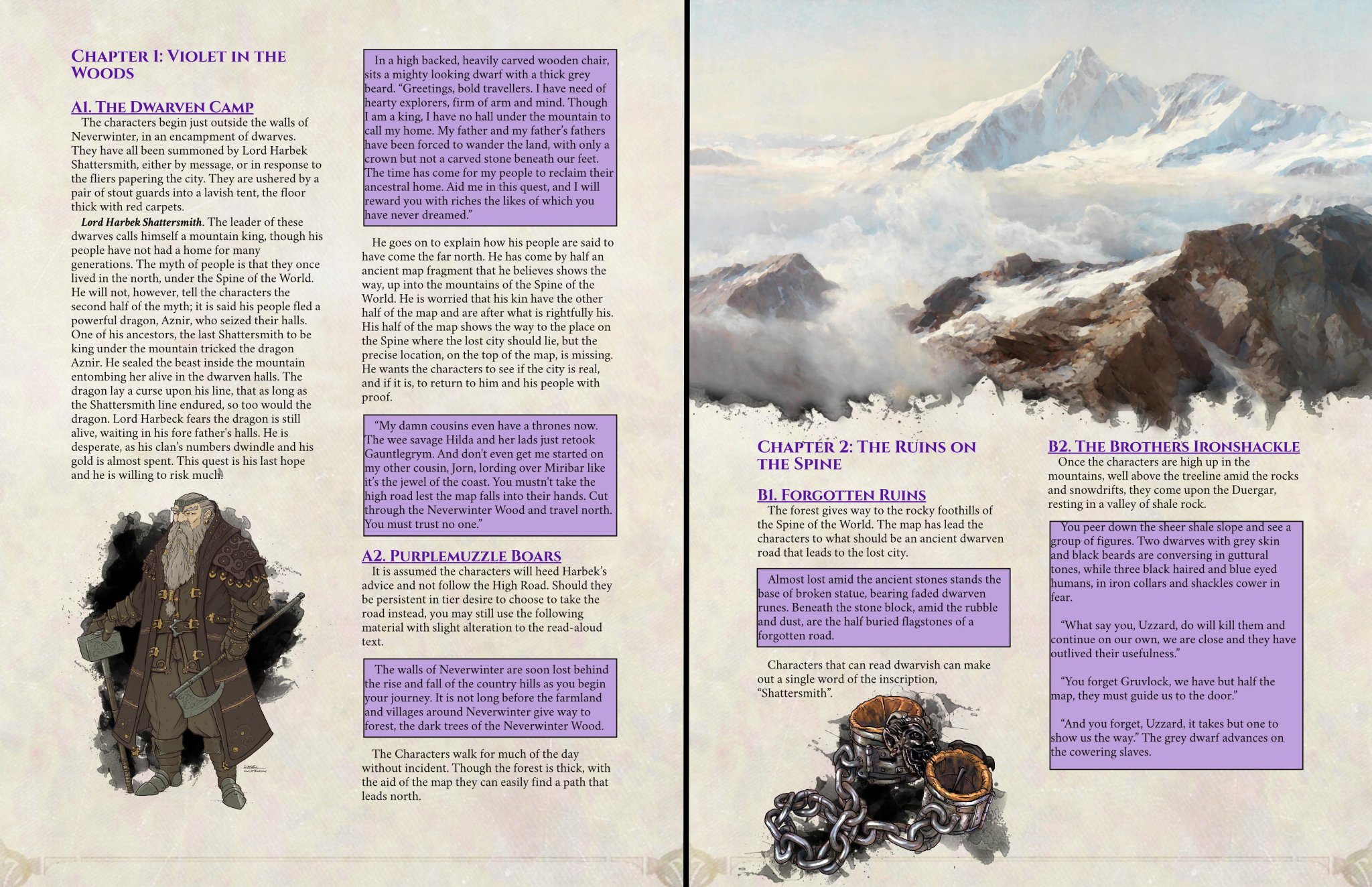I've followed Sly Flourish's Twitter for a little more than five years--since roughly the start of the hype for D&D Next/5e. Until this week, I haven't had a chance to actually look at the physical, published work of Mike Shea (the person behind the Sly Flourish "brand"). My wife bought me a copy of the original Lazy Dungeon Master and in between holiday festivities I've happily read through it, using my read-through as a perfect opportunity to test out note-taking in my other Christmas gift, a Rocketbook.
This post, then, does two things: it serves as a look back at what DMing advice looked like before D&D's fifth edition, and it serves as a rough "review" of Shea's original text on the subject.
On page 7, Shea posits the central idea of his project: "Think back over...the most memorable moments...How many were pre-scripted by the DM and how many were memorable simply because no one...had any idea what was about to happen[?]"
Honestly? Almost always, the best moments I've seen while DMing (or as a player) were judiciously prepared ahead of time; a critical choice or even roll is the focus--an inexchangeable contribution by players--but that moment itself is well-prepared far in advance.
I agree with Shea that the story is build "while the game runs at the table," but, for my players at least, the direction of that story is often set in motion ahead of time.
On page 8, Shea proposes that DMs should "keep [the] choices down to three."
This is solid advice in almost every arena of player interaction. Fewer than three choices can feel scripted. (It must be either this or that!) More than three can feel overwhelming very quickly. Even in the most advanced open-world games, if we're completely directionless the games often become merely playgrounds. Think of the difference between playing Minecraft and playing Skyrim: Both could be satisfying, but only the second is a roleplaying game.
Shea walks DMs through the process with a sample adventure scheme and asks DMs to create their
own as he unveils the process. One of his first questions is, "Where does your adventure begin?" This is good advice in the pre-5e world. If we're truly doing the start of a campaign, I might replace that now with, "How do the PCs know each other? Why are they together?" I followed the advice and attempted to generate three areas the PCs might encounter/explore, three notable NPCs, and 3 villainous NPCs. I have gone through exercises like this before, and while I find them helpful in theory, I seldom end up using anything I generate in actual play. Perhaps ironically, I find that the time I spend on such exercises is wasted (for me). I hope it actually stretches my creative muscles, but I have no evidence to suggest that it does.
On page 15, Shea recommends "Don't sell an ending you can't deliver." Put another way, he recommends letting players drive the story. This is sound advice for a group of "active" players! Most of the players I deal with are in the "lazy" category. They are explorers, traveling through the game world like tourists. They want to see, they want to experience, and they want to solve puzzles (in addition to clobbering monsters and becoming more powerful). Put another way, they're not looking for adventure, they're looking for adventure to find them! If there's no world-ending threat, their experience is somehow diminished. It's not to say that an occasional side-quest or silly session can't be rewarding--they are!--but rather that the reason my players play is both to spend time with other/have fun and to be heroes. Shea is right that we shouldn't sell endings we can't deliver, but I'd rather look at this as: "Don't forget to deliver on the ending you've sold!" I don't want to play in a campaign without the ending I "bought."
On page 26, Shea writes his sixteenth section on "Reskinning". It's solid advice. Never re-create what you can just re-skin! Flavor is easy to change; mechanical calibrations take a lot of time and the chances are that someone has already done it for you. On page 28, Shea (crediting Dave Chalker) introduces the term "Combat Outs" to describe methods a DM might use to end a combat early. I love the term and I'm surprised I didn't come across it sooner. In the same section, Shea talks about how maybe we over-prepare the mechanics of monster strongholds and posits that we could probably get by with the knowledge that there is a stronghold and that it has X number of creatures guarding it. As a DM, I need a LOT more guidance to work with ahead of time than how many monsters there are. How big is the complex? How many of the creatures guard the doors? Are sleeping? Are fighting? What are the rest doing? Eating? Slaving? Gambling? Without that info in advance, I'm likely to treat them as mindless traps, coming to life when the PCs are present in empty, faceless rooms and becoming inert and inactive otherwise.
Pages 29-30 are the most dated in the book. Credit to Shea, though, as he foreshadows both the way 5e deals with experience (milestones) and ascending power bonuses (proficiency). His "PC Wish List" has a charm to it, but takes a lot of the fun out of random loot. What I've done in the past is to ask PCs to choose/make a single magic item for their character that I, as DM, will supply as a reward or piece of loot at some point in the campaign. That way, PCs get the opportunity to be a part of a reward system without taking away the majority of the fun of random loot!
On pages 31-32, Shea offers his critique of using published materials. His objections revolve around the time costs of preparing them and the "generic" nature of them. He's right about both. I suspect the generic nature is one of the reasons published campaigns so seldom write their way through the upper teens to make characters level 20 (and simultaneously, why so many campaigns don't make it to the upper teens). Regarding that preparation, I find it useful time spent because any moment spent preparing for a published campaign is guaranteed effective; it points somewhere! The story/arc are present, the clues/foreshadowing are already figured out, all that has to be done is to drop players in and let them play. Preparing or running a homebrew (or "lazy") game may end in a dead-end. Published campaigns don't. It requires "active" players to maintain the momentum of a "lazy" campaign; I don't sustain that as a player, and I think it might be a tough sell for my own players! As far as the "generic" part, that's where using them "loosely" as "inspiration, not gospel" comes in and makes sense. Running published adventures can't be done slavishly in the best of conditions, but it needs to be done artfully to be done well.
On page 33, Shea writes that we should "delegate to the most distracted" player(s), and this is excellent advice at any game table. Give players responsibilities that are simple but recurring. On page 34, Shea skates the surface of what "Lazy Dungeon Mastering" is all about: Improving Improvisation. Improv is a very important skill; in the home games I've been a part of, however, solving the "big mystery" that defines the campaign is one of the main reasons we enjoy it together! Improv for NPCs, voices, side-quests--that's all exceptionally good and useful. On the other hand, improvising the campaign from a single seed is...too undeveloped for me. If that mystery isn't there to unravel, it doesn't matter what the "trust" situation" is like. Having said that, most of the section contains great advice: practice, practice, practice, and ultimately aim for relaxed awareness at the table.
The last section of the book involves transcriptions of his interviews with ten notable DMs. I think this section was the most shocking in that the DMs overwhelmingly (eight out of ten!) were in favor of a lot of preparation before their games.
What all ten seemed to agree on:
- DMs are not novelists or lore developers: don't waste time on extraneous lore or world-building. Let all of that flow naturally.
- Mechanical effects are important when designing set-piece encounters, but almost none of the DMs mentioned monster or NPC stat creation. Their time was spent on the personality or motives of NPCs/monsters. Stats come from the manuals.
- The best sessions blossom when PCs respond to the DM and the DM responds to the players.
Overall, I'm glad I read it, but in retrospect, I should probably have read Return of the Lazy Dungeon Master instead!
One side note that bothered me as a teacher of English is the number of typos. Shea does need to hire an editor for future projects!


